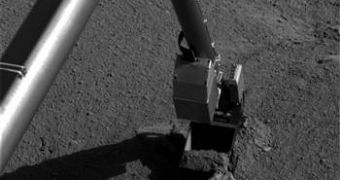Laboratory tests carried out on Earth showed that the Phoenix Mars Lander needs to expose more of the ice bellow the dusty layer on the surface of the planet if researchers want to collect a proper sample for analysis. As a result, the robotic arm of the spacecraft was instructed on Monday to extend an already dug up trench known as 'Snow White' from 20 by 30 centimeters to 20 by 45 centimeters.
"Right now, there is not enough real estate of dark icy soil in the trench to do a sample acquisition test and later a full-up acquisition for analysis," said Ray Arvidson of the Washington University, co-investigator for Phoenix's robotic arm.
After the samples are collected they are delivered to the Thermal and Evolved-Gas Analyzer, TEGA for short, and heated up inside small ovens only to generate gases that are then analyzed in order to determine the chemical composition of the soil.
The robotic arm will again use its rasp to scrape the hard ice layer; however, this time all of the loose material will be collected, unlike during previous experiments when samples have been prepared for analysis albeit afterwards they have been left aside. No icy material was included in the previous examinations carried out by the spacecraft's wet chemistry laboratory and optical microscope.
Also, last week Phoenix conducted an electric and heat conductivity experiment by sticking a device resembling a fork into the surface of the Red Planet.
"The Phoenix science team is working diligently to analyze the results of the tests from these various instruments. The preliminary signatures we are seeing are intriguing. Before we release results, we want to verify that our interpretations are correct by conducting laboratory tests," said Peter Smith of the University of Arizona, principal investigator for the mission.
Once the experiment was complete, the robotic arm was commanded to extract the device from the soil during which time it touched a rock dubbed 'Alice' and automatically stopped, according to the instructions of the program controlling its movement. The arm resumed its activity on Monday when new commands were imputed, instructing it to move away from the rock and start uncovering more ice in the 'Snow White' trench.

 14 DAY TRIAL //
14 DAY TRIAL //